It’s been a while since I’ve had a chance to post. Things got a little hectic toward the end of my stay in Tonga, and my re-entry into urban life has been as chaotic as usual. But I’ve finally settled back into (some semblance of) a normal routine, and I’m hard at work catching up on my to-do list mountain.
Final Calf Encounter
Before departing Tonga, I was fortunate enough to have one last encounter, with a humpback whale calf that I had not come across before...Fanima (female), the 45th(!!!) calf of the season.
Fanima was a big baby when I met her. I estimate that the mini-Megaptera was close to half the length of her mother, which suggests that she was born early in the season.
Perhaps in part because the calf was relatively mature, mom was laid back. She seemed, in fact, almost entirely unconcerned with what the little one got up to. Fanima played and splashed at the surface with considerable vigour, executed many a whimsical twirl, checked the boat out on multiple occasions, and peered with intense curiosity at anyone in the water.
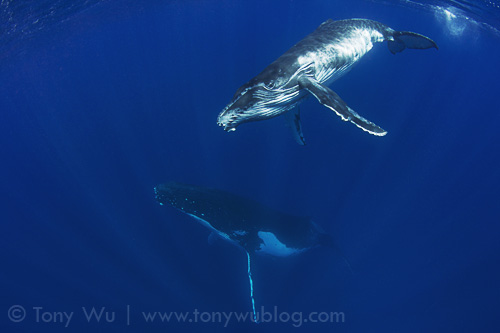
Fanima (calf #45) was my final calf encounter for the 2011 season.
Given her relatively large size, Fanima was probably born early in the season.
We did, however, have a bit of drama.
Before I had a chance to take any photos, an escort appeared without warning out of the deep, surging up beneath Fanima’s resting mother, waking the female from her slumber. Not surprisingly, Fanima’s mom bolted, with calf in tow. Females of any species...as it turns out...don’t enjoy being taken by surprise.
When escorts approach suddenly like this, relaxed mother/ calf pairs often take off and swim at high speed for considerable distances.
I was alone in the water at the time, and groaned in despair at the prospect of having lost the opportunity to ID the calf.
Fortunately, mother and baby settled again after only a few minutes. Mommy, it seems, decided that she liked the escort and let him stay. Whew! I’ve seen this happen before, but less often than I’ve seen the swim-swim-swim-away scenario play out.
With that, we spent a wonderful hour or so cavorting with Fanima, mother and escort...a perfect way to wrap-up an incredible season of humpback whale encounters.
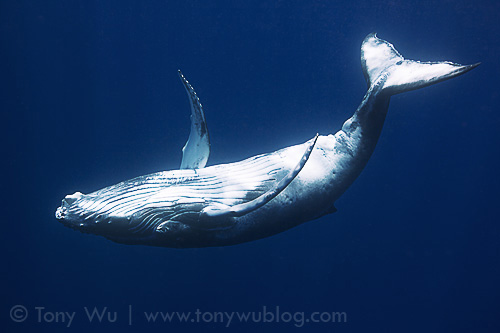
Humpback whale calf Fanima having fun swimming upside-down
Incredible Season
2011 was my tenth humpback whale season in Tonga, my ninth consecutive one.
It was also the most amazing. I think I learned more about humpback whale behaviour over the past two months than I have in all the other seasons combined!
The relatively high number of whales this season was certainly a big factor. After all, the more whales there are, the more there is to see.
But I think the cumulative weight of previous experience may have tipped the scales as well. Bits and pieces from seasons past seemed to fall into place, affording me a glimpse of the bigger picture...like the moment when a jigsaw puzzle finally coalesces.
I’m still processing everything I experienced and learned this season, but here are some key points that come to mind:
Record number of baby whales: To date, I’ve ID-ed 45 humpback whale mother/ calf pairs. My previous record was 31 mother/ calf pairs in 2009, set out in this file: humpback whale calf count file for 2009.
I have to double-check the IDs to make sure I didn’t double count, but I have a reasonably high degree of confidence in this tally, given the many(!) hours I’ve invested squinting at the finer details of whale body patterns, dorsal fins, flukes and other markings. Of course, I’m hoping to receive additional data that will increase the final count, but in any event, I’m 100% certain that there were many more babies in the area.
Record-breaking mother was a repeat from 2009: The mother that broke the previous high count of 31 was a female that I had previously ID-ed with a calf in 2009. The female in question was the mother of Luna (calf #13, female, in 2009) and returned this season with Toluua (calf #32, female). I recognised the mom on sight because of her unique dorsal fin, but also...more interestingly...because of her personality/ disposition. See Part 5 for a discussion of this inspiring encounter.
This is now the third female I’ve documented returning with a second calf. There might be more repeat mothers in this year’s crop. I just haven’t had time to do a methodical comparison yet.
Worst visibility ever: The underwater visibility this season was consistently the most mucked-up and worst that I’ve experienced to date. There have, of course, been periods of poor visibility before, but the less-than-ideal conditions persisted for the entire season. Visibility was poor far offshore as well, in areas that would be clear under more normal circumstances.
I have no idea what caused this prolonged phenomenon. I’m guessing it’s a lingering effect of the prolonged El Niño/ La Niña cycle that finally ended a while ago, but really...who knows?
Earliest whales ever: Somewhat offsetting the bad visibility was the fact that the whales showed up as early as I can recall. I wasn’t in Tonga at the time, but I received reliable reports of whale sightings in June, with the first babies spotted in late June. To put that in perspective, I usually expect the earliest humpback whale calfs to be spotted in mid- to late-July or so.
You might recall that the whales showed up relatively late last year, so this marks a stark contrast between the two consecutive seasons.
One thing I’ve been keen to see is whether the whales leave Tonga earlier than usual as a result of their early arrival in the area. We’re a third of the way through October now, and while the number of whales has declined, it seems like there are still quite a few around, as one would expect at this stage in a “normal” season. I’ve received several reports of excellent in-water encounters over the past few days.
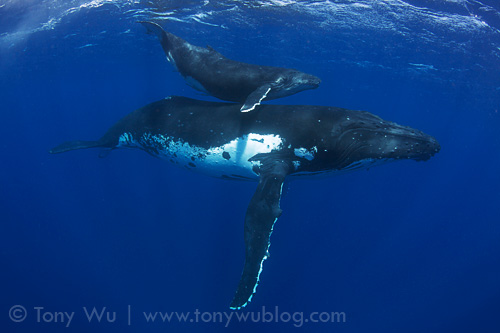
Toluua (calf #32), who's mom is the same as the mother of Luna, calf #13 of 2009!
Lots of whales as well: Going hand-in-hand with the early arrival of the whales was the seemingly high number of humpbacks.
Last season, it seemed as if there weren’t as many whales around as in a given "average" season. This year, there were certainly some days when there were few whales to be found, but in general, an abundance of whales characterised the season.
Go figure...Escorts are actually interesting: I’ve always considered escort whales that associate with mother/ calf pairs a bit of a nuisance. They often “push” the female/ baby whales and make them swim at high speed for prolonged periods, making it difficult to get a look in the water, much less take photos.
But I started noticing a few things about the escorts this season.
For instance, in Part 3 of my updates, I documented one escort hounding two separate mother/ calf pairs (calf #17 Tahafita and calf #18 Tahavalu) on consecutive days, with both mother/ calf pairs seemingly doing their best to get away from the pesky male in question. I named him “Two-timer”.
Two-timer’s plight was a clear contrast to the way that the presence of an escort seemed to settle Tolu’s (calf #3, male) mom, as I described in Part 2, and also to the way that Tahafa’s (calf #14, male) mom seemed to take comfort in the presence of her long-term escort, as I set out in Part 5. Recall also from the write-up about Fanima (calf #45, female) above, that Fanima’s mom only took a few minutes to accept the presence of the escort.
Perhaps this is obvious, but it seems that female humpbacks are receptive to overtures from some males, but not others.
I’ve also seen this behaviour among sperm whales, where females seem to “like” or “not like” individual adult males, so perhaps this is a universal phenomenon? (For my own good, I’ll resist the temptation to draw any parallels to human female behaviour, however obvious.)
Escort relationships can be long term: I had always assumed that escort relationships with mother/ calf pairs were relatively short term. Actually, to be more accurate, I hadn’t given the topic much thought, as ID-ing mother/ calf pairs was my priority, and escorts were just sort of “in the way”.
This season, I’ve documented two relatively long-term relationships between an escort and a mother/ calf pair.
The first involved Tahafa (calf #14, male), with a single escort staying with the mother/ calf pair for a period of at least 14 days (1 to 14 September), as I described in Part 6. The second was Faua (calf #42, female), with a single escort present from 20 September to 7 October, a span of 18 days (just received photo documentation of this latest sighting).
My understanding from communicating with researcher friends in Hawaii is that no one else seems to have documented such long-term associations between an escort and a mother/ calf pair before. (If you know of any such documentation, please clue me in!)
Perhaps this is a phenomenon unique to the whales that frequent Tonga; perhaps it’s a fluke (excuse the horrible pun); or perhaps this happens elsewhere as well, but hasn’t been documented because it’s difficult to follow a particular escort + mother/ calf for an extended period.
Of additional interest, both of these escort + mother/ calf groups travelled the 40km distance between Vava’u and Toku. Maybe having an escort around is something mothers prefer when crossing open ocean? (See discussion of Pseudorca attacks below.)
In any event, picking up on these fascinating escort/ mother/ calf dynamics has sparked my interest in escorts, and from this season forward, I’ll be keeping records of the number of escorts we see with mother/ calf pairs, as well as taking careful notes on their behaviour, and photographing them more carefully for ID purposes (just what I need...more self-imposed work!).
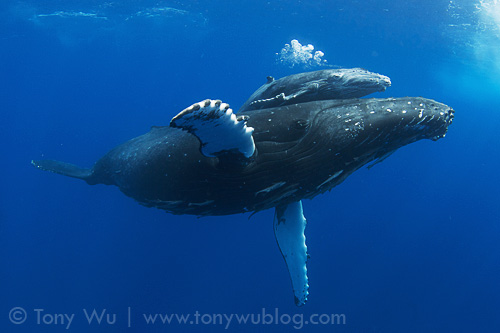
Tahafa (calf #14), the undisputed star of the season
Singing escorts: One other escort behaviour that has me scratching my head is singing. Most people associate singing behaviour with lone males, hanging in the blue, belting out their haunting melodies. Males can also sing while they swim. In fact, “travelling singers” seem to be nearly as common as stationary ones, at least in Tonga.
But over the years, we’ve also come across a number of males singing when they’re with mother/ calf pairs. Again, I haven’t kept meticulous records of this, but in general, this seems to take place when more than one male is involved. It can sometimes be when the whales are resting, and at other times, when the whales are swimming.
We had two such observations this season. The first was with Uataha (calf #21). Two males approached the mother/ calf pair; there was a bit of commotion; and then there was an escort with the mother and calf...singing. The whales settled in shallow water, not moving much.
The second instance involved Tahafa (calf #14, male). In this case, there were multiple males challenging the primary escort repeatedly over the course of many hours. Amid the chaos and pandemonium, at least one of the males was singing...really loud! I think it was the primary, long-term escort, but I can’t be certain. There was a lot of action, and the whales definitely weren’t settled.
What does this mean? I’m not sure, but I do know that humpback whale singing behaviour is much more complex and nuanced than a lone male crooning while hanging head-down in the water.
Escort ratio is high: One final note about escorts...the ratio of mother/ calf pairs with at least one escort present is high in Tonga. This season, out of a given 10 mother/ calf pair encounters, somewhere between 4 and 5 will have had an escort or more (I’ll have a precise figure after I review all the data). My understanding is that such a high prevalence of escorts with mother/ calf pairs is unusual.
If you think about it, escorts should prefer single females over ones with babies, on the assumption that escorts are males looking to mate.
From memory, the ratio has always been high in Tonga, but again, I haven’t kept careful records to date. I did keep careful records this year though, so when I produce my calf count summary for this season, it will include a breakdown of escort relationships as well.
More about this topic in Part 6.
Pseudorca attacks: With the combined evidence from the injuries on Tahafa (calf #14, male), Fafa (calf #44, female), Fitu (calf #7) and Uanoa (calf #20, male), the case for false killer whale attacks on humpback whale babies around Tonga seems like an open-and-shut case.
Maybe such attacks are a contributing factor to reason why there are long-term escort + mom/ calf pair relationships discussed above?
It will be interesting to see whether we come across more such attacks in the future, and also if we see these particular babies back in Tonga in upcoming seasons. Scarring should make it relatively easy to spot them, assuming they survive and also return to Tonga.
See Part 7 for a detailed discussion of the rationale for pointing the finger at Pseudorca crassidens.
Travelling mother/ calf pairs: This season, we’ve ID-ed three mother/ calf pairs that have moved between Vava’u and Toku: Tahafa (calf #14, male); Uatolu (calf #23, female); Faua (calf #42, male).
I’ve always taken it for granted that mother/ calf pairs travel, and my data from previous years has suggested that Vava’u is more of a stopover place than a long-term home, but it’s nice to have incontrovertible photographic and GPS proof.
Abundance of white pecs: Whales with all-white pectoral fins were back in numbers this season. I haven’t done a final count, but we photographed at least 10, including, for the first time, two babies with all-white pectorals fins...Uafitu (calf #27) and Faua (calf #42, male). Faua’s mom also has white pecs.
Why is this important? Because whales with all-white pectoral fins are relatively easy to spot and track, and there usually aren’t that many that visit Tonga. This is only the second season during which I’ve come across so many of them. Last year, for instance, I didn’t see any, though friends report seeing one, possibly two.
What this suggests to me is that it’s not always the same group of whales visiting Vava’u.
Dearth of split dorsal fins: Along similar lines, we only came across two whales with split dorsal fins this year. Actually, it was more like 1.5, since one of the two only had a mild split.
Why is this important? Because whales with split dorsal fins are also easy to recognise. Last season, there were quite a few. In most seasons, like this one, there are zero to extremely few.
This again suggests to me that it’s not always the same group of whales visiting Vava’u.
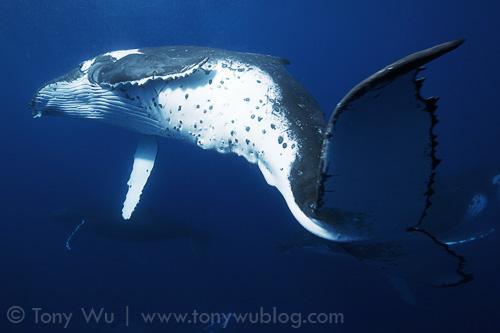
Male humpback whale swimming past at high speed,
fending off challengers for the female (dark whale visible lower left background)
Lots of singers; bass not so bass: There seemed to be a relative abundance of singers this season. This probably makes sense, given the apparent abundance of whales overall. Somewhat unexpected, however, was the number of singers we came across toward the end of the season.
I generally expect there to be more singers early in the season, because I believe that singing is part of the interaction/ communication/ competition among males in association with social status and securing the right to mate.
Early in the season, there should be more females around, so I’d expect competition to be high. Toward the end of the season, there should be relatively few whales remaining (including eligible females), so logically, there should be less competition among males.
This year, however, half of the 14 singer encounters we logged took place between 14 and 22 September, pretty late in the season...so once again, the whales defied my efforts to make sense of their behaviour.
Also worth noting, the bass in the song this season wasn’t quite as deep and booming as I’ve experienced in the past. Even while hanging a couple of metres directly above singers on multiple occasions, I didn’t feel the same “oomph” that usually characterises the low notes in humpback whale song.
Crystal Ball Gazing (Sort of)
Last year, I felt reasonably confident about setting out a case for a baby boom this season, because the deck seemed to be stacked that way. There were babies around, but not a record number by any means, and we came across a lot of behaviour associated with reproduction.
This year, there were heaps of whales and lots of babies. It seemed like there was a reasonable level of mating-associated activity....heat runs, courting pairs and such...but not quite as much as in 2010.
So what do I think is going to happen next season?
To be honest...I have no clue.
With so many babies born this year, probability should favour fewer, rather than more, little ones next season.
But...no one really knows how the greater population of southern humpbacks decides where to go. Judging by the ever-changing number of white-pec whales and individuals with split dorsal fins, for instance, I don’t believe that the same whales visit Tonga each season. I think it’s more likely that individual whales cycle around various areas, which could explain why we more often see readily ID-able individuals every couple/ few years, rather than in consecutive seasons.
As such, there is certainly some chance that a significant proportion of female whales that have mated elsewhere this year will, for some reason, again converge in Tonga, resulting in another baby boom. From memory, there were lots of babies in the consecutive seasons of 2004 and 2005, for instance.
On the other hand, there were relatively few babies in 2008, moderate numbers in 2006, 2007, 2010, and very high numbers in 2009 and 2011.
So basically...there’s no obvious pattern. There are without doubt a host of variables at play, most of which we probably don’t know about, much less understand.
If I had to make a guess though, I’d wager the chances of another 40+ baby year are relatively low, and we’ll end up with a count in the 20s. In other words...a reversion to the mean.
While I’m taking a stab in the dark, I’ll go out on a limb and predict substantially better visibility, on the theory that the particles in the water are the result of prolonged rains and warm weather due to the El Niño/ La Niña cycle.
Time will tell if gut instinct is pointing me in the right direction, or if the whales, weather and water outsmart me.
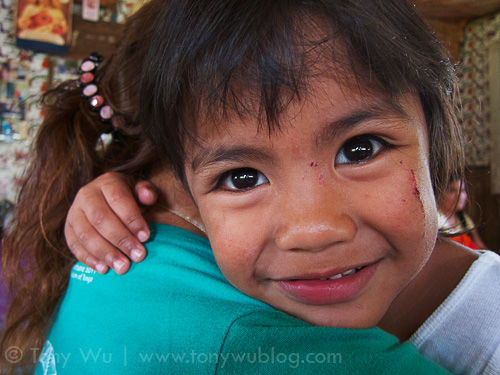
One of my best friends in Tonga
Wrap-Up
I’d like to wrap up my final long-form blog post for the 2011 humpback whale season with a really big “Thank You!”
Even though I’m doing all the work of keeping track of whales, cataloging photos, recording GPS data, taking notes and producing the summary file, a lot of people have contributed to the calf sighting and ID process...some of whom I’ve named in my periodic updates this season, most of whom I have not.
Some people have contributed photos and sighting data; others have contributed knowledge and experience, responding to my numerous emails and other messages that start with: “Do you happen to know...?”.
I’m particularly grateful for the trust and friendship of everyone who has travelled to Tonga with me, not just this season, but in past years as well. Besides having lots of fun, you have made it possible for me to spend the time to collect and collate my annual calf count data.
During and after each season, I spend hundreds of hours going through the data collected, organising it, and parsing it into easily understandable format. Then I put together a summary file and Google Maps, which I post to the internet...so that anyone who is interested can see the results. (I’m getting to work on the 2011 file now!)
In short, your generosity and support have allowed me to crowd-fund this research effort.
So to sign off for now...to all the people who have joined me this season and in the past, from the United States, Japan, Singapore, Taiwan, China, Thailand, Hong Kong, Korea, Sweden, Russia and Canada...Thank you, 有り難うございました, 谢谢, ขอบคุณครับ, 감사합니다, tack, Спасибо, and for the Canadians...Thank you, eh.
I’ll post my 2011 summary file as soon as I can (with 45+ babies to work through, it’s going to take a while!), and also my Tonga trip schedule for 2012.
If you’d like to consider travelling to Tonga with me next season, please drop me a short note via my contact form.
Previous Posts from the 2011 Humpback Season in Tonga:
Swimming with Humpback Whales in Tonga | 2011 Season Part 1
Swimming with Humpback Whales in Tonga | 2011 Season Part 2
Swimming with Humpback Whales in Tonga | 2011 Season Part 3
Swimming with Humpback Whales in Tonga | 2011 Season Part 4
Swimming with Humpback Whales in Tonga | 2011 Season Part 5
Swimming with Humpback Whales in Tonga | 2011 Season Part 6
Swimming with Humpback Whales in Tonga | 2011 Season Part 7
Previous Calf Count Summary Files and Maps:
Humpback Whale Calf Count, 2009
Humpback Whale Calf Count, 2010

A treat of delicious homemade gelato
from my friends Franco and 'Ofa to bid us farewell